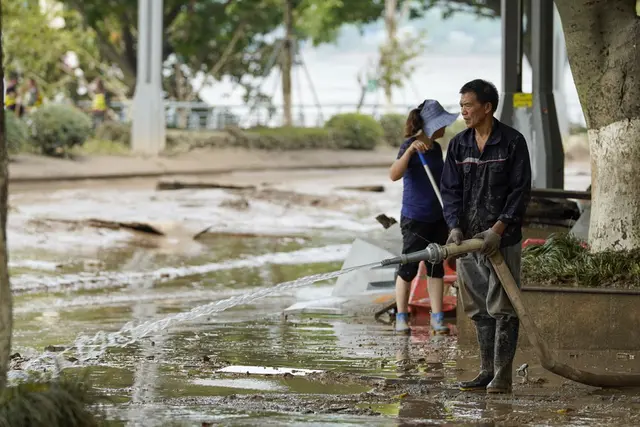People clean out a road in southwest China's Chongqing Municipality, Aug. 22, 2020. Floodwater in southwest China's Chongqing Municipality started receding as the water level at the Cuntan hydrologic station fell below the alarm level of 180.5 meters at 8 a.m. Saturday. Disaster relief and production resumption are underway. (Xinhua/Liu Chan)
CHONGQING, Aug. 22 (Xinhua) -- Floodwater in southwest China's Chongqing Municipality started receding with water levels at major hydrologic stations dropping below alarm levels.
The metropolis on Saturday afternoon downgraded its flood emergency response from the top level to level four, the lowest rung in the country's four-tier emergency response system.
The water level at the Cuntan hydrologic station fell below the alarm level of 180.5 meters at 8 a.m. Saturday. The water flow at the station also dropped from the peak of 74,600 cubic meters per second to 36,300 cubic meters per second, according to station sources.
Water at Caiyuanba and Chaotianmen hydrologic stations was also flowing below warning levels.
Chongqing saw the biggest flood of this year as the water level at the Cuntan station reached 191.55 meters, 0.14 meters higher than the record in 1981, at around 8 a.m. Thursday. This made the municipality activate a top-level response to the floods.
The floods caused an emergency evacuation of 251,000 people and inundated 23,700 shops, but did not lead to deaths, according to the city's emergency management bureau.
Disaster relief and production resumption are underway, with gas supply resuming for 15,000 households.
Yan Yonghui, an official with Chongqing's flood control and drought relief headquarters, said the emergency response was downgraded instead of being lifted as the municipality still faces an urgent task to restore its life and production to normalcy.
"We face an arduous task of recovery and reconstruction. Apart from dredging and disinfection, we are also pressing on with repair and reconstruction of damaged infrastructures like roads, bridges, water supply facilities, electricity, communication and gas pipelines," Yan said. ■
 简体中文
简体中文

